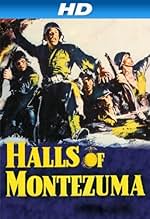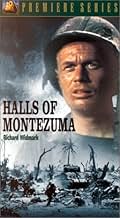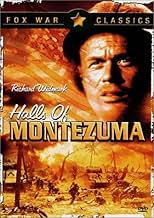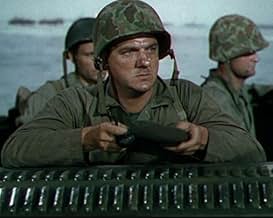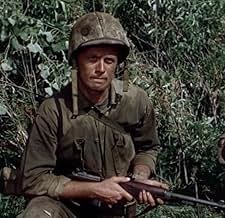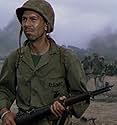IMDb RATING
6.6/10
3.1K
YOUR RATING
A company of Marines races against the clock to find a Japanese rocket base.A company of Marines races against the clock to find a Japanese rocket base.A company of Marines races against the clock to find a Japanese rocket base.
Jack Palance
- Pigeon Lane
- (as Walter {Jack} Palance)
Richard Allan
- Pvt. Stewart
- (uncredited)
Edward Binns
- First Soldier in Final Tracking Shot
- (uncredited)
Robert Board
- Marine
- (uncredited)
Robert Bohannon
- Soldier
- (uncredited)
- Director
- Writer
- All cast & crew
- Production, box office & more at IMDbPro
Featured reviews
Halls Of Montezuma is a busy, Technicolored war film circa 1950, and was a big hit in its day. The story-line, such as it is, is convoluted and not really worth going into. Basically the film is about the psychology of war and its effect on human relations, especially those created by the war itself. A good deal of the film, as I recall, takes place in caves, ditches and deserted buildings. Unlike most war films this one emphasizes the fact the most soldiers, even Marines, are made, not born; they all come from someplace and would like to return there, preferably in one piece. Lewis Milestone directed the picture, and while it is a far cry from his classic All Quiet On the Western Front, this film is no shabby piece of work. Richard Widmark heads a cast of future stars, and they all perform well, if a bit too strenuously at times. The actors tend to be grouped together a good deal, maybe to ensure that no one can outshine anyone else, and this, plus the emphasis on isolated settings, succeeds in making the film strangely intimate. The color is bright and often glaring, and the Pacific island setting well-rendered. It's worth mentioning as a footnote that the studio that made the picture, 20th Century-Fox, would soon be switching over to making almost exclusively CinemaScope films, and would also soon be dropping Technicolor for the cheaper De Luxe color. Their post CinemaScope product is for the most part vastly inferior than what they previously had been doing, and Halls Of Montezuma, while not a great film, shows, even today, just how beautiful Technicolor could be. This, plus the use of the square, tidy space movies were limited to in those pre-wide screen days, makes for a depth in perspective that is at times almost seductive, even in so grim a film as this.
At age 10, in 1960, I watched the "Halls of Montezuma" movie on television. In 1968, I found myself in the U.S. Marine Corps serving as a machine-gunner in the infantry. Sometimes, movies have a way of becoming true reality; and, because the movie gave me a little insight and understanding of the brutality of war, in some way, I owe a debt of gratitude to the movie.
- Despite it's grand name, Halls of Montezuma is a small war film. What I mean is that the movie focuses more on a small group of men and their fears and problems than it does on a grand plan for Allied victory. It's a very personal movie. We get to see these men up-close and we begin to develop feelings for them. I wouldn't doubt that this is one of the first films to show a U.S. Lieutenant so battle scarred that he resorts to using pain killers just to function. Unlike other war films of this era, not all of these men are going to make it to the end. War is like that. It doesn't pick and chose people to live because we like them. So in that regard, it's also more realistic than some other war movies made in the 50s.
- To succeed as a small, personal war movie as I've described, the cast has to be able to act. This cast does not disappoint. Richard Widmark, Jack Webb, and Karl Malden are all excellent in their respective roles. I was especially impressed with Webb who has an acting style that can grate on the nerves. He's more subdued here and it works. But as good as these three are, Jack Palance is the highlight of the movie for me. He was undoubtedly the most believable. I could really picture him doing the things in real life that were called for in the script.
- I have no difficulty recommending Halls of Montezuma to fans of war films. It's a very welcome addition to my DVD collection.
Many war movies just following WWII were of the John Wayne tough guy type. However, Halls of Montezuma, is refreshing in that it looks in depth at the psychology of the soldier. Really at how men change when laying there lives on the line. The cinematography was also well done when you consider this movie was made half a century ago. You won't see the blood and guts as in a Saving Private Ryan, but the movie may make you think twice before signing up for active duty.
Arguably, it's one of the three or four best WWII movies ever made. A group of U.S. Marines race against the clock to find the source of enemy rockets that prevent them from taking control of a Japanese-held Pacific island. It's certainly a patriotic film. But there is also an undercurrent of despair, based on the human toll that war inevitably takes.
These Leathernecks are tough, but they are also subject to death from enemy fire. And the screen story puts a lot of emphasis on individual characterization. I don't recall a film that did such a good job of combining scene transitions with flashbacks to help viewers understand the motivations of the main characters.
Lt. Anderson (Richard Widmark) is the leader; he suffers from debilitating migraine headaches, but nevertheless pushes on to fulfill whatever dangerous mission he's assigned. One of his men is Conroy (Richard Hylton) who used to stutter, until Anderson helped cure him of it years earlier. Slattery (Bert Freed) is your typical Marine toughie, but he's got a sense of humor and conceals a portable still to make booze. Pretty Boy (Skip Homeier) is a pistol packing dude with a chip on his shoulder. Through the screen story's deep characterizations, viewers naturally become attached to these guys, and root for them as they enter into their dangerous mission. Of the dozen or so men Anderson leads, not all will make it out alive.
As in other battle films, viewers learn the importance of quick decisions, teamwork, effective communication, and keen awareness of one's surroundings. Life occurs moment by moment, in the here and now. Make a plan; execute it; dodge a problem; ignore pain and fatigue; persist. These are lessons applicable to anyone at any time, not just warriors on the battlefield.
"Halls Of Montezuma" is a quality production all the way. The color cinematography is fine, despite the fact that some of the techniques are dated. The ensemble acting is credible. The editing and scene transitions are just terrific. And, as the film's bookends, that rousing theme song: "From the halls of Montezuma to the shores of Tripoli" gets the viewer in the right frame of mind.
I normally don't care for movies in this genre. Even this film, like other WWII films, is a tad too predictable, slightly manipulative, and contains some outdated assumptions. Nevertheless, as war movies go, "Halls Of Montezuma" is one of the best.
These Leathernecks are tough, but they are also subject to death from enemy fire. And the screen story puts a lot of emphasis on individual characterization. I don't recall a film that did such a good job of combining scene transitions with flashbacks to help viewers understand the motivations of the main characters.
Lt. Anderson (Richard Widmark) is the leader; he suffers from debilitating migraine headaches, but nevertheless pushes on to fulfill whatever dangerous mission he's assigned. One of his men is Conroy (Richard Hylton) who used to stutter, until Anderson helped cure him of it years earlier. Slattery (Bert Freed) is your typical Marine toughie, but he's got a sense of humor and conceals a portable still to make booze. Pretty Boy (Skip Homeier) is a pistol packing dude with a chip on his shoulder. Through the screen story's deep characterizations, viewers naturally become attached to these guys, and root for them as they enter into their dangerous mission. Of the dozen or so men Anderson leads, not all will make it out alive.
As in other battle films, viewers learn the importance of quick decisions, teamwork, effective communication, and keen awareness of one's surroundings. Life occurs moment by moment, in the here and now. Make a plan; execute it; dodge a problem; ignore pain and fatigue; persist. These are lessons applicable to anyone at any time, not just warriors on the battlefield.
"Halls Of Montezuma" is a quality production all the way. The color cinematography is fine, despite the fact that some of the techniques are dated. The ensemble acting is credible. The editing and scene transitions are just terrific. And, as the film's bookends, that rousing theme song: "From the halls of Montezuma to the shores of Tripoli" gets the viewer in the right frame of mind.
I normally don't care for movies in this genre. Even this film, like other WWII films, is a tad too predictable, slightly manipulative, and contains some outdated assumptions. Nevertheless, as war movies go, "Halls Of Montezuma" is one of the best.
Did you know
- TriviaUS Marine and Navy units participated in the filming of this movie and after their work was finished, they went to fight in Korea.
- GoofsWhile speaking to his superiors on his walkie-talkie, Lt Anderson twice closes his conversation with "Over and out." This is incorrect. He should have said either "Over" (if he was turning the conversation over to the other speaker), or "Out" (if he was ending the talk). Interestingly, Anderson uses the correct term "Out" later in the film.
- Quotes
Sgt. Randolph Johnson: Wasn't there a comment by your General Sherman about war?
Lt. Butterfield: Yeah, he said, "War is Hell." What did he know, that eight-ball never left the States.
- Crazy creditsCurrent prints open with the mid 1980's 20th Century Fox logo.
- ConnectionsEdited into Tarawa, tête de pont (1958)
- SoundtracksMarines' Hymn
(uncredited)
Music from the "Gendarmes' Duet" from the opera "Geneviève de Brabant"
Written by Jacques Offenbach
Sung over the opening credits
Also played during the first landing
- How long is Halls of Montezuma?Powered by Alexa
Details
- Release date
- Country of origin
- Languages
- Also known as
- Okinawa
- Filming locations
- Marine Corps Base Camp Pendleton, California, USA(I know this, as my father was in boot camp at the time and his squad were used as extras for four days at this location, for this film.)
- Production company
- See more company credits at IMDbPro
- Runtime1 hour 53 minutes
- Aspect ratio
- 1.37 : 1
Contribute to this page
Suggest an edit or add missing content

Top Gap
By what name was Okinawa : Le Verdun du Pacifique (1951) officially released in India in English?
Answer

